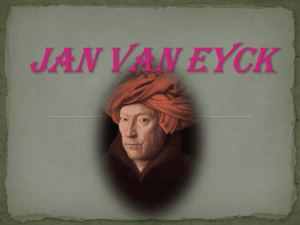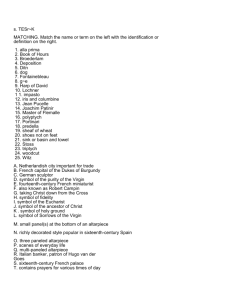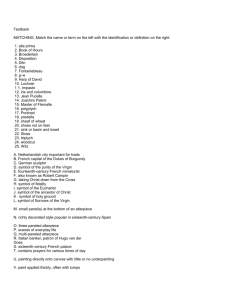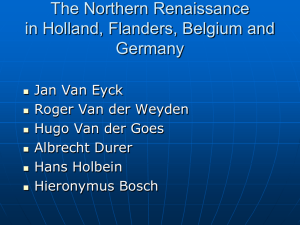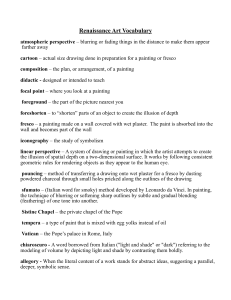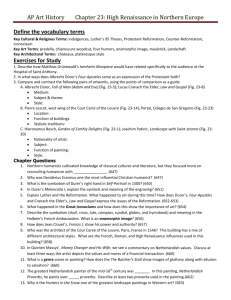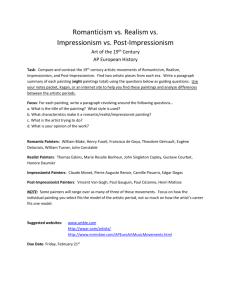chp 14-north ren
advertisement
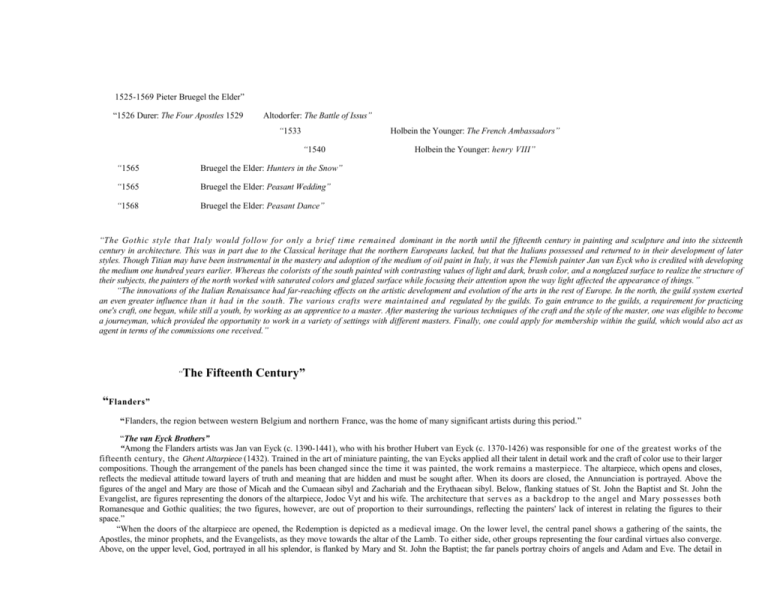
1525-1569 Pieter Bruegel the Elder” “1526 Durer: The Four Apostles 1529 Altodorfer: The Battle of Issus” “1533 Holbein the Younger: The French Ambassadors” “1540 “1565 Bruegel the Elder: Hunters in the Snow” “1565 Bruegel the Elder: Peasant Wedding” “1568 Bruegel the Elder: Peasant Dance” Holbein the Younger: henry VIII” “The Gothic style that Italy would follow for only a brief time remained dominant in the north until the fifteenth century in painting and sculpture and into the sixteenth century in architecture. This was in part due to the Classical heritage that the northern Europeans lacked, but that the Italians possessed and returned to in their development of later styles. Though Titian may have been instrumental in the mastery and adoption of the medium of oil paint in Italy, it was the Flemish painter Jan van Eyck who is credited with developing the medium one hundred years earlier. Whereas the colorists of the south painted with contrasting values of light and dark, brash color, and a nonglazed surface to realize the structure of their subjects, the painters of the north worked with saturated colors and glazed surface while focusing their attention upon the way light affected the appearance of things.” “The innovations of the Italian Renaissance had far-reaching effects on the artistic development and evolution of the arts in the rest of Europe. In the north, the guild system exerted an even greater influence than it had in the south. The various crafts were maintained and regulated by the guilds. To gain entrance to the guilds, a requirement for practicing one's craft, one began, while still a youth, by working as an apprentice to a master. After mastering the various techniques of the craft and the style of the master, one was eligible to become a journeyman, which provided the opportunity to work in a variety of settings with different masters. Finally, one could apply for membership within the guild, which would also act as agent in terms of the commissions one received.” “The Fifteenth Century” “Flanders” “Flanders, the region between western Belgium and northern France, was the home of many significant artists during this period.” “The van Eyck Brothers” “Among the Flanders artists was Jan van Eyck (c. 1390-1441), who with his brother Hubert van Eyck (c. 1370-1426) was responsible for one of the greatest works of the fifteenth century, the Ghent Altarpiece (1432). Trained in the art of miniature painting, the van Eycks applied all their talent in detail work and the craft of color use to their larger compositions. Though the arrangement of the panels has been changed since the time it was painted, the work remains a masterpiece. The altarpiece, which opens and closes, reflects the medieval attitude toward layers of truth and meaning that are hidden and must be sought after. When its doors are closed, the Annunciation is portrayed. Above the figures of the angel and Mary are those of Micah and the Cumaean sibyl and Zachariah and the Erythaean sibyl. Below, flanking statues of St. John the Baptist and St. John the Evangelist, are figures representing the donors of the altarpiece, Jodoc Vyt and his wife. The architecture that serves as a backdrop to the angel and Mary possesses both Romanesque and Gothic qualities; the two figures, however, are out of proportion to their surroundings, reflecting the painters' lack of interest in relating the figures to their space.” “When the doors of the altarpiece are opened, the Redemption is depicted as a medieval image. On the lower level, the central panel shows a gathering of the saints, the Apostles, the minor prophets, and the Evangelists, as they move towards the altar of the Lamb. To either side, other groups representing the four cardinal virtues also converge. Above, on the upper level, God, portrayed in all his splendor, is flanked by Mary and St. John the Baptist; the far panels portray choirs of angels and Adam and Eve. The detail in these panels is exquisite, the saturation of color, captivating. Though the subject depicted is spiritual in nature,“its portrayal and representation arc realistic and natural, a contradiction that cannot but hold the attention of the viewer and inspire awe.” “Another painting that illustrates Jan van Eyck's skill in applying the art of the miniature to larger works is his Virgin with the Canon van der Paele (1436). Here again, van Eyck has differentiated the various surfaces through his use of exquisite color to create textures and contrasts. Though the color is brilliant, he is careful to keep it from overpowering the composition in terms of subject. The work also illustrates the artist's use of multiple perspective as a way to focus the viewer's attention upon the major subjects of the painting. His intent was not, like that of Italian painters, to create a sense of unified three-dimensional space but rather to arrange his figures upon a twodimensional surface through the use of color and shape. His subjects are rigidly poised, with little suggestion of movement or action.” “In 1434 Jan van Eyck did a portrait, Giovanni Arnolfini and His Bride, which is secular in subject matter but possesses the spiritual atmosphere of his other works. Additionally, as with his religious paintings, it is laden with symbolism, though here that symbolism is related to the institution of marriage. The two figures stand while holding hands, reliving their marriage vows. Their shoes, which they have taken off because their ceremony has made the room a holy place, lie on the floor; a small dog in the foreground represents the fidelity of marriage. Other symbolic images abound; the drawn curtains of the marriage bed, the bedpost where sits a statuette of the patron saint of childbirth, St. Margaret, and more.” “Rogier van der Weyden” “Rogier van der Weyden (1400-1464), known for his paintings of religious themes, did not focus upon the image as symbol, as did van Eyck, but rather upon the image as portrayer of emotion, often sorrow and anguish. His Escorial Deposition (1435) is such a painting. Here he limits the space within which the event takes place, thus concentrating the attention of the viewer on the characters.” “Petrus Christus” “It is not known whether Petrus Christus (1410-1472) actually spent time in Italy, but his depiction of space and treatment of the figure reflect the style popular in Italy during this period. Although critics have commented that he was influenced by both Jan van Eyck and Rogier” “van der Weyden, his work shows his interest in the underlying structure of his subjects rather than in their surface appearance. The three figures in Christus' painting The Legend of Saints Eligus and Godeberta (1449) illustrate this attention to form.” “Dirk Bouts and One-Point Perspective” “The first painting of this period in the north known to utilize one-point perspective in the depiction of interior space is The Last Supper (1464-1468), the middle panel of the Altarpiece of the Holy Sacrament, by Dirk Bouts (1415-1475). Here the projecting lines of the composition come together just above the head of Christ, the centrally placed figure in the painting, and the room within which the event takes place conveys a real sense of depth and volume. Unlike his predecessors, Bouts also seems to have made some effort to adjust the proportions of his figures to be more appropriate for the space within which he has placed them. There is little evidence to suggest that his depiction of space was based upon the Italian use of perspective; it seems likely that he developed the application on his own. The tone of Bouts' painting is rather static, which might also lead one to conclude that his intent was more to depict space in a particular fashion than to create an image that would overwhelm the viewer with its drama and emotion.” “Hieronymus Bosch” “Hieronymus Bosch (c. 1450-1516) is probably best known for his triptych The Garden of Earthly Delights (1510-1515), a work whose symbolism and meaning are still debated, though it is likely that during the artist's time his visual allusions and metaphors were understood within the context of the culture. His imagery is both erotic and frightening. The panels depict a number of Old Testament and New Testament themes but in what many consider to be a rather bizarre fashion. In the left panel, Eve is portrayed as a temptress rather than as the mother of the human race. The central image depicts the foibles of humankind taking place within a surreal landscape; and the horrors of hell are graphically illustrated in the right panel.” “France” “Jean Fouquet” “InFrance, the work of the most prominent French painter of the” “fifteenth century, Jean Fouquet (1420-1481), was influenced by both Flemish and Italian painting, as seen in his painting Etienne Chevalier and St. Stephen (1450). Though the format of the composition is fairly standard fare for Flemish painting (the three-quarter view of the figures; the standing saint and the kneeling figure making an offering), the artist's attention to the underlying structure of the figures rather than the overt surfaces is distinctly Italian in style, as is his depiction of space through the use of architectural perspective. Another difference worth noting is the manner in which Fouquet has presented the two subjects of his painting. The distinction between saint and man is not so obvious in their manner of dress or appearance, narrowing the gap between this world and the next.” “Germany” “German painting of the fifteenth century was also influenced by the work of the Flemish painters. The integration of the Flemish style in Germany varied from the soft, ornate style of Stephan Lochner (14001435), as seen in his Madonna in the Rose Garden (1430-1435), to the harsher manner of Conrad Witz's (1400-1447) The Miraculous Draught of Fish (1444).” “The Sixteenth Century” “Flanders” “During the sixteenth century the Italian manner continued to influence the direction of northern art, though in many different ways. It was also during this period that the influence of the German painters grew, while that of the Flemish painters waned. ” “Pieter Bruegel the Elder” “That is not to say that there were no Flemish painters worth noting, for there were, especially Pieter Bruegel the Elder (1525 -1569). Bruegel created landscapes that were more than simply places of human” “activity; they were subjects worthy of attention in their own right. This orientation may be seen in his Hunters in the Snow (1565), one of the paintings among a series he did portraying the months of the year. Here, though the attention of the viewer is upon the men returning from the hunt, their wives tending the fire, and the townspeople skating on frozen ponds, it is impossible to ignore the vast landscape.” “For his human subjects, Bruegel did not limit himself to one particular social stratum; in fact, he did many paintings of peasant life. The characters depicted in his Peasant Wedding (1565) may seem somewhat flat and unidimensional, but this plainness of treatment conveys a sense of simplicity and what life is like in the country. Though the subject is peasant life, the wedding is nonetheless treated in a solemn fashion. Similarly, his painting The Peasant Dance (1568) is alive with the energy of a country festival, while at the same time it serves as a social commentary in the way he has placed his characters (facing away from the town church), and in his placement of a picture of the Madonna (attached to a tree on the right).” “Germany” “Though some German artists, such as Albrecht Durer (1471-1528), went to Italy to study the art of the south, others were content to remain in Germany and learn of the Italian manner secondhand, incorporating into their own style those elements that appealed to them. Among the regional styles that developed in Germany was the Donaustil, or Danube, style, in which artists such as Albrecht Altodorfer (1480-1538) painted. The Donaustil represented a genre of landscape painting that emphasized 'feeling and emotion. Although the detail of Altodorfer's work tends to be similar to that of the miniaturists, his The Battle of Issus (1529) presents the viewer with an immense vista in which humans are portrayed as minute figures in the cosmos.” “Matthias Grunewald” “Mathis Niethardt, better known as Matthias Grunewald (c. 14801528), represented the German equivalent of the Italian Renaissance man. During his life, he served as architect, engineer, and painter. Between 1510 and 1515 he painted the panels for the Isenheim Altarpiece for the Monastery Church of the Order of St. Anthony at Isenheim. When the altarpiece is closed, the exposed panels depict the Crucifixion, but not in a manner that had been seen before. Grunewald's version represents one of the most unsettling versions of that subject ever created. The crucified Christ is portrayed in a dark landscape in all his agony, his body showing the effects of the abuse he has suffered. He seems to convulse in spasm, and his hands are taut, with fingers extended in torment. To the right of Christ, the Virgin Mary, St. John, and Mary Magdalen despair at the death of Christ the man, while to Christ's left, St. John the Baptist serenely points to Christ the savior.” “In contrast to the dark suffering and tragedy of The Crucifixion are the uplifting panels within the altarpiece: Annunciation, Angel Concert for the Madonna and Child, and The Resurrection. The Resurrection is especially luminous in its portrayal of Christ floating up toward heaven. Where Grunewald used color in The Crucifixion to create a dark sense of tragedy and earthly pain, he masterfully used color to create an unearthly sense of light and hope in The Resurrection.” “Albrecht Durer” “It is likely that when German artists began to travel to Italy to study the Renaissance style of the south, Albrecht Durer (1471-1528) was among the first to go. He was so impressed with what he found in Italy that upon returning to the north, he made it his cause to expose his contemporaries to the style of the Italian Renaissance. Though trained as a goldsmith, it is for his prints that he is especially known, and his fame as a craftsman in the art of the woodcut and engraving is as great today as it was during the sixteenth century.” “Durer's unique handling of the woodcut may be seen in his The Riders on the Four Horses from the Apocalypse (c. 1496) [see illustration 71 which was part of a series of woodcuts he did to illustrate The Revelations of Saint John, from the New Testament. His portrayal of Death trampling a church official, Famine swinging his scales, War with raised sword, and Pestilence with bow and arrow drawn was of a type very different from the traditional woodblock print, which was typically a black and white image with limited contrast. Using the woodcut, Durer was able to incorporate a range of lights and darks (chiaroscuro) that had never been achieved with this medium. By using subtle techniques adopted from the art of engraving, Durer was able to convey a visual sense of mass to his figures that otherwise would have been impossible to accomplish with woodcuts.” “7. Durer, Albrecht. The Riders on the Four Horses From the Apocalypse. (c. 1496)” “Wood Cut.” “The Metropolitan Museum of Art,” “Gift of Junius S. Morgan, 1919. (19.73. 209)” “Durer was also fascinated with the self-portrait and during his lifetime he did many of them. His Self-Portrait of 1500 is notable for its serious, intent expression and frontal pose. Durer's interest in the Italian Renaissance also led him to investigate systematically the depiction of idealized proportions for the human figure. His engraving The Fall of Man (1504), also known as Adam and Eve, portrays Adam and Eve as idealized, not real-life figures. Though they do not quite seem to belong there, they are placed against the backdrop of a forest whose detail implies great attention to nature on the part of the artist. Whereas the figure of Adam is similar to the Italian conception of the perfect male form, that of Eve retains more of the German proportions. Durer has also followed the northern tradition of incorporating a number of visual symbols into his composition. For example, the cat and mouse in the foreground symbolize the tension between Adam and Eve as she offers him the fruit from the Tree of Knowledge of Good and Evil. ” “Durer valued and cultivated his skill of observation, through which he felt he could gain a special kind of knowledge. His respect for nature is reflected in his watercolor The Great Piece of Turf (1503), which is as realistic as it is "true." This particular work is significant in that it is what it appears to be-a still-life-and does not incorporate elements of symbolism in order to legitimize its existence.” “Though there may have been some sense of disparity between the influences of naturalism and idealism in Durer's The Fall of Man (1504), he seems to have at least somewhat resolved the conflict by 1513, when he did the engraving Knight, Death, and Devil. Here, the horse and rider, though idealized, work together within the context of the composition.” “Durer's paintings of religious themes oftentimes carried political overtones as well. In The Four Apostles (1526), presented by Durer to the city of Nuremburg as a gift, the Apostles John and Peter are pictured in one panel, Mark and Paul in the second. Though the overt message is a religious one, the passages from the New Testament inscribed upon the panel frames warn against the actions of man being misinterpreted as the will of God, probably in reference to the friction between the Catholic church and the Protestant movement at the time.” “Hans Holbein the Younger” “Another German artist who integrated the northern manner of realism with the Italian dimension of monumentality was Hans Holbein” “the Younger (1497-1543). Holbein's skills are especially evident in his portraits. The French Ambassadors (1533) illustrates his attention to detail, as seen in the pattern of the floor tiles and the drapery. His sense of organization lends stability and strength to the work, and his use of color adds richness.” “One of Holbein's most famous portraits is of Henry VIII (1540). The pose is rigid, and it is obvious that the artist spent much time attending to the minute detail of his subject's costume. It is the king's mass, however, that has the most impact upon the viewer; it gives the impression that this is not an individual to be trifled with.” ““ “
